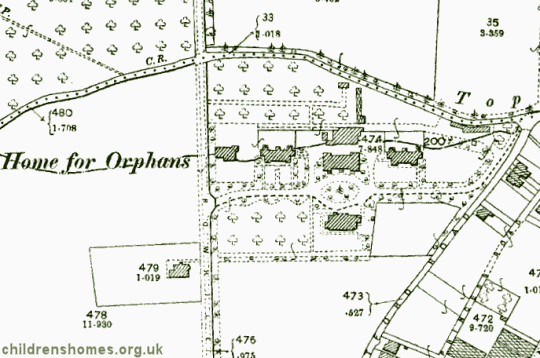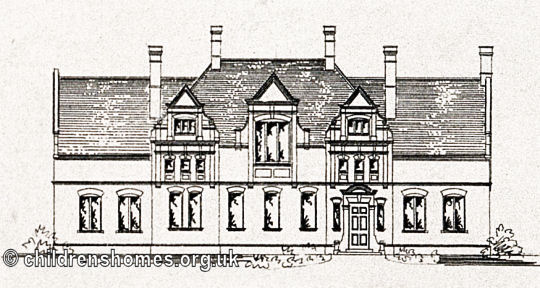Home for Little Boys, Hextable, near Swanley, Kent
The Home for Little Boys (also known as the Home for Orphan Boys) was established in 1875 by the same body that ran the boys' home at Farningham. Whereas the Farningham home aimed to house boys who were completely destitute, the new home was intended to accommodate those whose relatives or friends could make a contribution to their maintenance. In its early years, the home was advertised as catering 'the fatherless boys of domestic servants and others in like circumstances.' Its intake later became the 'fatherless or motherless boys of respectable parents, who have not received parish relief.' An annual payment of £20 a year was required for each boy accepted, with admissions limited to those under the age of twelve.
Initially, the home had premises at Edgware but soon developed plans for a new building on a site at Rowhill Road, Hextable, near Swanley, not far from the existing Farningham home.
The location and layout of the Swanley home are shown on the 1895 map below.

Home for Little Boys site, Swanley, c.1895.
The new buildings, designed by Messrs Spalding and Auld, were in the Queen Anne style and constructed in red brick with slate roofs. The full scheme for the site provided for two pairs of "Dames'" or "Mothers'" Homes, a central school block, and houses for the Headmaster and for two Assistant Masters. The architect's plan of the western and central parts of the site is shown below, with the envisaged second pair of Dames' Homes and Assistant Master's house being placed at the east of the school hall. Initially, just three blocks were constructed: one pair of Dames' Homes, housing a total of fifty boys; the Headmaster's house, which included accommodation for forty boys and two Assistant Masters; and the school hall. Subsequent construction of the additional blocks took the total capacity of the home to 200. The new buildings were officially opened on July 20th, 1883, by the Prince and Princess of Wales (the later King Edward VII and Queen Alexandra).

Home for Little Boys site plan, Swanley, c.1882. © Peter Higginbotham

School block at Home for Little Boys, Swanley, c.1882. © Peter Higginbotham

Headmaster's house at Home for Little Boys, Swanley, c.1882. © Peter Higginbotham
Boys at the home received instruction in a wide variety of trades and skills. By the 1890s, these included: carpentry, wood carving, farm and garden work, needlework, knitting, blacksmithing, plumbing, fretwork, photography and collotype printing. The home also had its own military-style band.
At the start of the twentieth century, Sir Christopher Furness, owner of the Furness shipping line, became Chairman of the home's Committee. As a supporter of naval training, he financed the building of the home's Lady Furness House where boys could receive training in skills that would prepare them for a career in the Merchant Navy.
An account of life at the home between 1935 and 1940 has kindly been contributed by Hylton Dawson.
During the Second World War, the home was severely damaged by incendiary bombs. The staff and pupils were evacuated to Devon in 1944.
Following a reorganisation of the Swanley and Farningham homes in 1949, Swanley became a voluntary controlled primary school for the younger boys housed at Swanley plus some from Farningham. In 1955, the Swanley site was taken over by Kent County Council and the boys in residence were transferred to Farningham. On January 1st, 1957, the Hextable Special School opened on the site, providing support for children with learning difficulties. It was renamed the Furness School in 1962. In 1986, the school was re-organised to cater for older pupils with emotional and behavioural problems. Since 2004, Furness School has dealt with pupils having severe emotional, behavioural and social difficulties.
Records
Note: many repositories impose a closure period of up to 100 years for records identifying individuals. Before travelling a long distance, always check that the records you want to consult will be available.
- Action For Children (formerly the National Children's Home, NCH) inherited records from the Farningham and Swanley Homes for Boys. Applications relating to these records should be made to NCH via the form on their website.
Bibliography
Links
Except where indicated, this page () © Peter Higginbotham. Contents may not be reproduced without permission.


